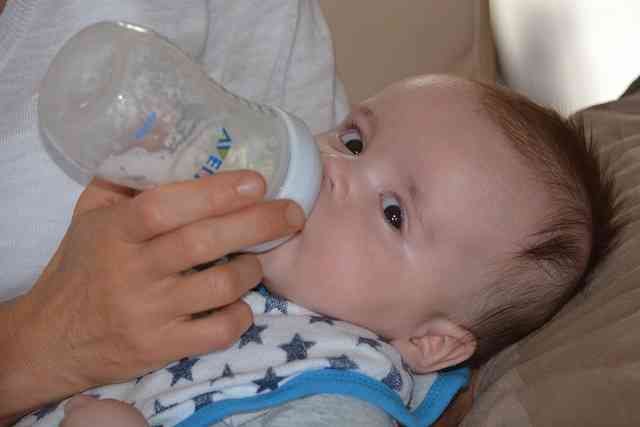When we were preparing for our child, one of the decisions we made was to occasionally bottle feed him. That seemed like a perfectly simple decision. You want to bottle feed? Just go to the store and buy a set of bottles. Little did I know just how complicated it can be to match a set of bottle nipples to your baby. There’s a bunch you need to keep in mind and monitor.
How exactly do baby bottle nipples work?
In the past, my uneducated days, these nipples always seemed like the baby’s first introduction to no-spill cups. Fill the bottle with liquid, no or little will come out unless the child is sucking.
Essentially, at its most basic, the nipple of a baby bottle is a small piece of flexible material with little tiny holes in it. Those tiny holes are what both allows the liquid to flow into your child’s mouth, and restrict the flow to minimize spills. As a baby grows they’ll need more and more milk, and they’ll be able to handle more at once, so you’ll use nipples with larger and/or more holes.
That’s the basic nipple. There are of course many, many other options to choose from. For example there is a type of nipple known as variable flow. Variable flow nipples use a different approach for controlling just how much milk is released. Instead of adding more holes, they include slots cut into the side of the nipple.
There will typically be three or four slots cut into different sides of the nipple, with each slot being a slightly different size. By controlling which slot is on the upper side of the bottle, you can control the flow of milk.
How do I know which level to choose?
This is a hard question to answer. Every baby is different, which means each baby has their own requirements and preferences for the nipple that they’ll accept. This means that at first it’ll be a guessing game.
The good news is that there are tools to help you. All nipples are labeled with a particular level. This level indicates the flow rate of the nipple, and you can use that flow rate as a general guide. Remember though that you start with a particular level and then watch your baby for signs that they are unhappy with it.
| Level | Recommended Age |
| Preemie | 0 months + (if your baby was born before the 37th week of pregnancy) |
| Level 1 | 0 – 3 months (assuming your baby was born at or after the 37th week of pregnancy) |
| Level 2 | 3 – 6 months |
| Level 3 | 6 – 9 months |
| Level 4 | 9 – 24 months |
What else should I look for in a baby bottle nipple?
As I said earlier, there’s many different features to consider when choosing a nipple. If your child is having a hard time accepting the bottle, then you might need to try several different combinations to find the right one for your child.
Brand
All bottles require a particular size of nipple that is capable of screwing onto the top of the bottle. So if you already have a set of bottles that you are now buying nipples for, you’ll need to make sure whatever you buy will fit your bottles.
If you are using a breast pump to feed your baby breast milk through a bottle, then your pump will likely require a certain brand of bottle. That in turn will limit you to nipples which fit that brand of bottle.
Shape
There’s two main shapes that a baby bottle nipple generally is available in: standard and orthodontic. Both offer different benefits and drawbacks that you’ll need to evaluate when choosing one.
Standard nipples are just that, standard. This is the most common type of nipple you’ll find, and therefore is the one that’s compatible with the most bottles. It is a tall, somewhat slender, and dome-shaped nipple. These nipples fit easily inside of your baby’s mouth and it is very easy for them to suck on them.
Orthodontic nipples are a very different shape, they are significantly wider at the base and tip while being slender in the middle. These are designed to mimic the shape of a mother’s breast more closely, and can help a baby who is having a hard time transitioning between the breast and bottle.
Material
Bottle nipples generally come in either Silicone or Latex. Both are a very soft and flexible material which is easy for the baby to compress with their little mouth.
Latex
Latex nipples are very soft. While this will feel great against a baby’s gums, it also means that they will wear out quickly. Be prepared to go through a couple sets of nipples. Because these are so soft, if your baby is having a hard time accepting a bottle, you’ll want to be sure to try a latex nipple.
These nipples will be BPA free, so you can rest easy about that. Unfortunately there is the potential for them to leach some carcinogens known as nitrosamines. In the United States, the Food and Drug Administration regulates the levels which can be present, but low levels might still be present.
Silicone
Silicone nipples are much sturdier than latex, so they’ll last a lot longer. However because they are a little firmer, your baby will need to chew a little harder to get the milk out of the bottle.
These nipples do not contain the potentially dangerous chemicals that can be present in latex nipples. However to be safe, try and look for nipples made with medical grade silicone when possible.
Ease of Cleaning
You’ll be cleaning baby bottles often, probably anywhere from four to eight a day depending on the age of your child. This means you’ll want a baby bottle, and nipple, that is very easy to clean.
Look for nipples that have a simple design that is easy to clean. Something without a lot of nooks and crannies that can collect food residue and grow bacteria. Most nipples are simple one piece items that satisfy this need, but there are some that include multiple pieces and are not all that simple.
How do I know when to switch to a different level of nipple?
When choosing a level for the nipples of your baby’s bottles, you need to choose one that provides the flow rate that your baby wants. At first it’ll just be an educated guess based on the table that I showed earlier, but after that you’ll either move up a level or down based on input from your baby. Here’s what to look for:
When to move down a level
If your baby is gulping, coughing, or showing signs they’re having trouble swallowing, it might be a sign they are receiving more milk from the bottle than they can handle and they are struggling to keep up. Or perhaps instead of trying to keep up, they just let the excess milk fall out of their mouth while swallowing the rest.
If you see those signs, or perhaps if the baby just starts refusing their bottle, you should try a lower level of nipple to see if that makes them happier.
When to move up a level
If your baby starts becoming fussy while feeding, then they might be frustrated with the flow. They want more milk than the bottle is providing, and they’re not happy. This doesn’t mean though that any time they are fussy you should move up. Look for a trend of fussiness where other factors, like illness, being too hot or cold, or over-tiredness are likely not a factor.
If your baby starts to fall asleep during feeding, when they otherwise wouldn’t, that could be another sign that they are getting enough milk. Perhaps the milk is flowing so slowly that they are getting bored, and falling asleep.
When should I stop using baby bottles?
Babies should stop using baby bottles by their first birthday. Since they can start developing tooth decay as soon as their teeth start appearing, the American Dental Academy encourages parents to start transitioning away from bottles after they reach six months of age. In case you are interested in reading more about this, here is the document published by the ADA concerning this .
.

